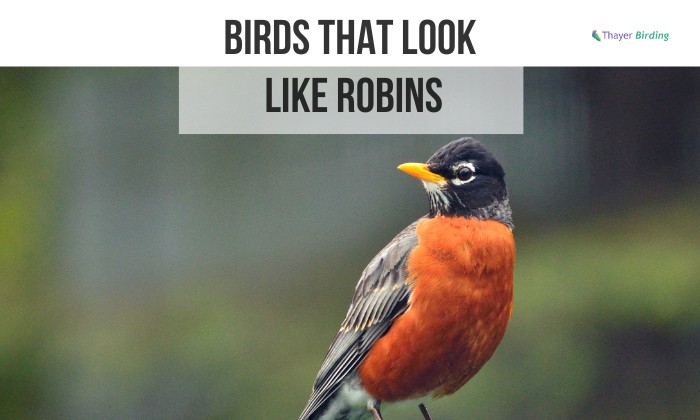There are several birds that look like robins, and you have probably mistaken one of them, too. It is not unusual for many to refer to any bird with a gray back and red-orange patch as an American Robin.
But what features does each look alike bird possess, and how to set them apart from a robin? In this list, we have 8 birds frequently confused as robins.
For an easy comparison, check out the table below:
| Bird Species | Beak | Legs | Breast | Markings | Size (in) |
| American Robin | Yellow | Brown | Red-Orange | Gray plumage, black tail, black and white wings and eye circles | 7.9 – 11 |
| American Redstart | Black | Black | Black | Orange or yellow patches in flight feathers | 4.3 – 5.5 |
| Hermit Thrush | Pale base, black tip | Brown | White with smudged spots | Reddish-brown sides | 6.5 |
| Spotted Towhee | Black | Brown | White with reddish-brown sides | Red eyes | 6.7 – 8.3 |
| Eastern Towhee | Black | Brown | Black with reddish sides | Reddish sides with white underparts, short triangular beak | 7 |
| Orchard Oriole | Black | Black | Yellowish | Black throat, slender body | 5.5 to 7.1 |
| Red-Breasted Nuthatch | Brown | Grey | Rust-colored | Two white stripes above and under the eye | 4.5 |
| Black-Headed Grosbeak | Gray | Black | Orange | Black head, white spots | 7.1 – 7.5 |
| Varied Thrush | Black | Yellow | Bright Orange | Black breastband, orange spots on the eye, back, and wings | 7.9 – 10.2 |
Table of Contents
Bird Species Resembling Robins
White crest? Yellow bill? Gray backs? Do you call it American Robin but aren’t? You are not alone. Many have similar incidences of confusing another bird for a robin.
Can you name some birds similar to robins? Some species you mentioned are probably on our list!
1. American Redstart
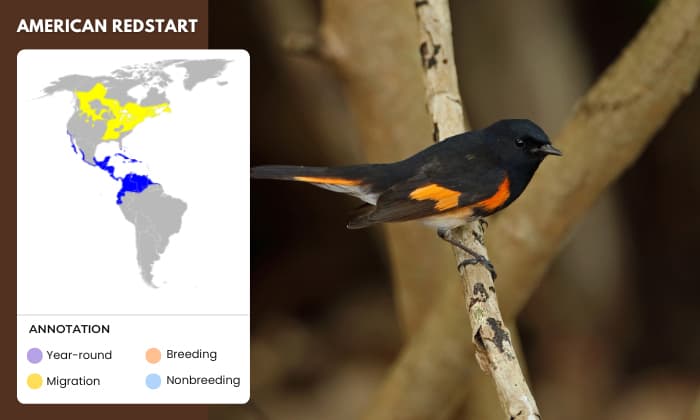
- Scientific Name: Setophaga ruticilla
- Weight Range: 6.9 to 8.7 grams
- Approximate Length: 11 to 14 centimeters
- Wingspan: 12 to 23 centimeters
These wood warblers are sometimes mistaken for small robins due to their dark head and reddish feathers.
Looking closely at their color pattern, males have black plumage, white bellies, and orange sides, wings, and tails. Females and juveniles share the same feathers except with yellow to yellow-orange patches instead of bright orange.
American Redstarts can be found across the United States besides the West Coast. They inhabit open deciduous forests and mixed woodlands or almost any treed habitats during migrations. You’ll see them fan out their tails, which is a distinct behavior that sets them apart from robins.
Their diet is mainly insects like caterpillars, midges, beetles, moths, aphids, crane flies, leafhoppers, and more. Sometimes, they also feed on berries and seeds.
2. Hermit Thrush
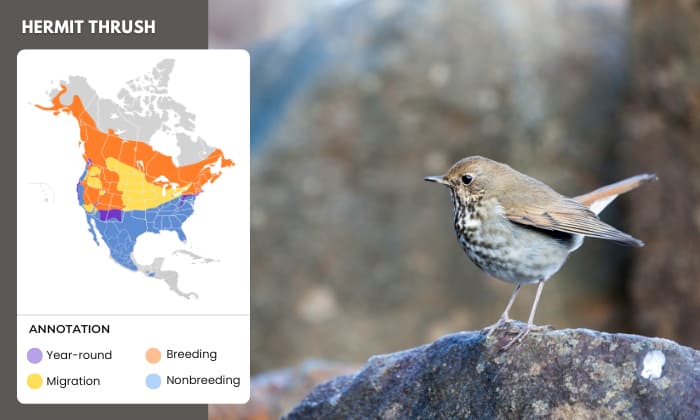
- Scientific Name: Catharus guttatus
- Weight Range: 23 to 37 grams
- Approximate Length: 14 to 18 centimeters
- Wingspan: 25 to 29 centimeters
This gray bird is often confused with a juvenile American Robin not only because of its coloring but also because of its shape, reddish feathers, beak shape, and eye ring. It has a round head, long tail, and chunky body like a robin but bigger. With speckled breast and throat, you can set it apart from a robin.
Hermit Thrushes occur in forest openings and edges, preferably in mixed or coniferous woods of southern Alaska, throughout Canada, western and northeastern America. This species is the only spotted thrush commonly found in North America, especially during winter.
These birds forage for berries and insects in shrubs, trees, and forest floors. Their diet includes grapes, elderberries, serviceberries, crickets, caterpillars, ants, earthworms, crickets, and more!
3. Spotted Towhee
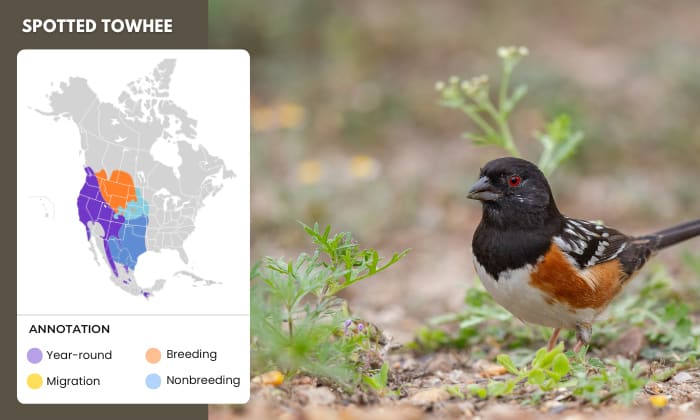
- Scientific Name: Pipilo maculatus
- Weight Range: 33 to 49 grams
- Approximate Length: 17 to 21 centimeters
- Wingspan: 28 centimeters
Formerly known as Rufous-sided Towhee, this towhee looks like a robin but brown with white spots on the back and wings. Look for the white chest and reddish-brown sides without the white markings on the face, so you don’t confuse this bird as a spotted robin.
Spotted Towhee can be found all over Washington, California, Arizona, Oregon, Idaho, Southern British Columbia, and anywhere with dry upland forests. These birds are also present in overgrown fields, backyards, and forest edges.
It is obvious when these birds forage leaves for food. Their diet is heavy in protein, especially during the breeding season, hunting for insects like spiders and beetles. When the climate starts to drop, they will find berries, seeds, and acorns.
4. Eastern Towhee

- Scientific Name: Pipilo erythrophthalmus
- Weight Range: 32 to 53 grams
- Approximate Length: 17.3 to 23 centimeters
- Wingspan: 20 to 30 centimeters
The scarlet feathers, tail length, and blackheads and blacks are the similar features Eastern Towhee share with robins.
To tell them apart, note that Towhee’s reddish color is on the side with white bottom parts. The short, triangular beaks and the smaller size are linked to Towhee’s and differentiate them from Robins.
Eastern Towhees, as its name suggests, frequents the eastern part of the United States along the border of North Carolina and Tennessee. They stay and forage in thickets, brush, tangles, and leaf litter next to forest edges.
The unique scratching techniques of these birds enable them to forage the ground and find buried seeds. Aside from seeds and fruits, Eastern Towhees feed on invertebrates and sometimes small amphibians like lizards and snakes.
5. Orchard Oriole
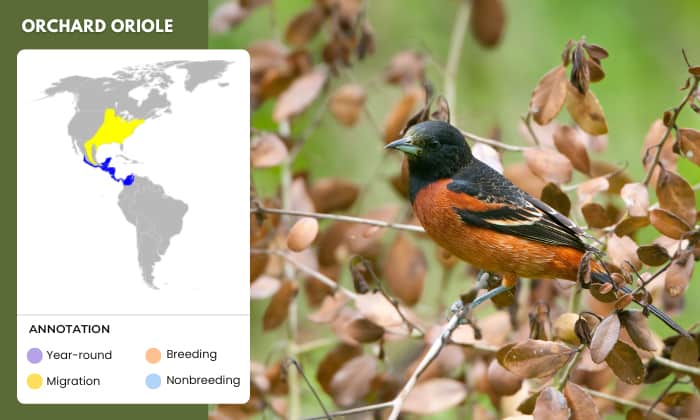
- Scientific Name: Icterus spurius
- Weight Range: 16 to 28 grams
- Approximate Length: 15 to 18 centimeters
- Wingspan: 25 centimeters
No wonder many are mistaking Orchard Orioles for Robins because of their dark head with red breast. Pay attention to the black bill and throat and the small, slender body; then you’ll know it is definitely an oriole and not a robin.
These songbirds are abundant in semi-open areas filled with deciduous trees. Orchard Orioles love to hang around places with scattered trees throughout eastern North America, extending to the Canadian border. Find them in parks, orchards, and along river edges.
Orchard Orioles feed on ripe fruits and nectars, another indicating factor that singles them out from robins. Their diet also includes insects and seeds. What they eat differs depending on the season.
6. Red-Breasted Nuthatch
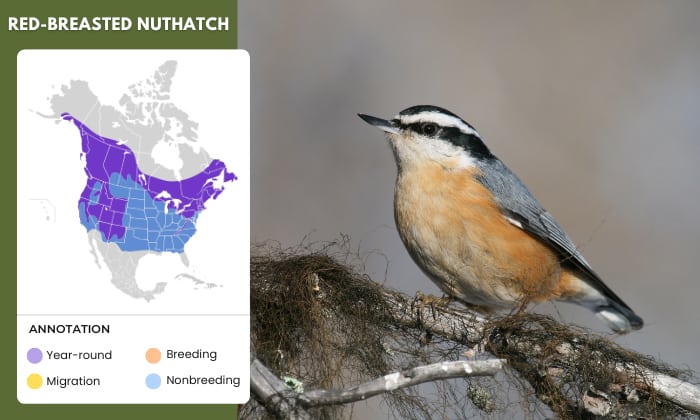
- Scientific Name: Sitta canadensis
- Weight Range: 8 to 13 grams
- Approximate Length: 11 centimeters
- Wingspan: 18 to 20 centimeters
The russet-colored chest and the gray upper parts cause confusion with the Red-breasted Nuthatch and the Robin. However, the former has strongly patterned heads and two white stripes on the top and bottom of the eye. They are also smaller than robins.
Red-breasted Nuthatches frequent coniferous woods and mountains. They settle as permanent north and alpine residents but sometimes extend to northern Mexico during the winter.
These acrobatic birds hop from one tree branch and trunk to another. They don’t seem to care which way is up as they creep from all corners, a unique behavior that tells them apart from the robins.
7. Black-headed Grosbeak
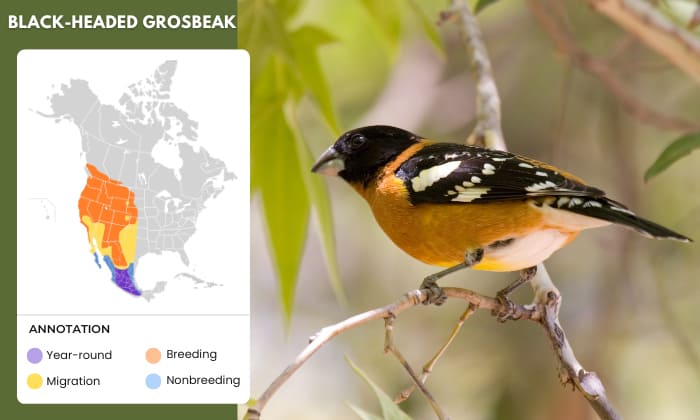
- Scientific Name: Pheucticus melanocephalus
- Weight Range: 35 to 49 grams
- Approximate Length: 18 to 19 centimeters
- Wingspan: 32 centimeters
These orange-breasted birds make it difficult for many to distinguish them from robins. It also does not help that both have the same body shape and yellow underparts.
The best way to differentiate them is the less vibrant plumage, shorter height, and white spots of the Grosbeak.
Black-headed Grosbeaks are widespread in the West, living around mountain forests, mixed woodlands, desert streams, gardens, and backyards. You will hear their quick and sweet vocalizations, which are longer and more textured than a robin’s.
These birds feed on protein-rich insects during the breeding season and fruits, berries, and seeds during the cold months. They are also known to consume monarch butterflies despite their poisonous nature.
8. Varied Thrush
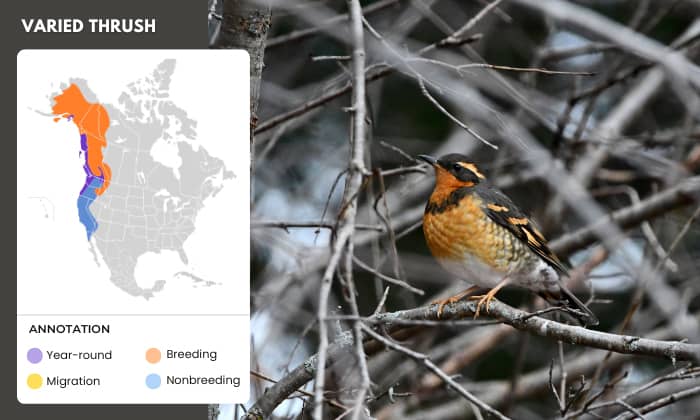
- Scientific Name: Ixoreus naevius
- Weight Range: 65 to 100 grams
- Approximate Length: 19 to 26 centimeters
- Wingspan: 34 to 38 centimeters
Varied Thrush belongs in the same family as robins. It is easy to confuse them since they have the same plumage color and often forage together in one flock. But the black breastband and vivid orange feathers with spots on the eye, back, and wings are characteristics unique to Varied Thrush.
This bird that looks like a fat robin, is native to the Pacific Northwest. It is migratory and travels to the south, but remains within its breeding range. They prefer mixed forests, humid evergreens, dense parks, gardens, and backyards.
It is easy to spot Varied Thrushes hoping in low shrubs, hunting insects in the summer and fruits and nuts when the cold season approaches.
Conclusion
How do you feel after knowing about the birds that look like robins? Do you think you can tell them apart? Does this list make it easier to compare and distinguish towhee vs robin?
We hope you learned a lot from this article and enjoyed reading it as much as we had fun putting it together. Now, you can determine if the bird species resemble robins or is the real one.

George and I became friends after a birdwatching trip with our new group. And we have been enjoying every adventure together. When he told me the idea of establishing a site that shares our experiences and fun, I immediately agreed. After trials and errors, here we have Thayerbirding.


